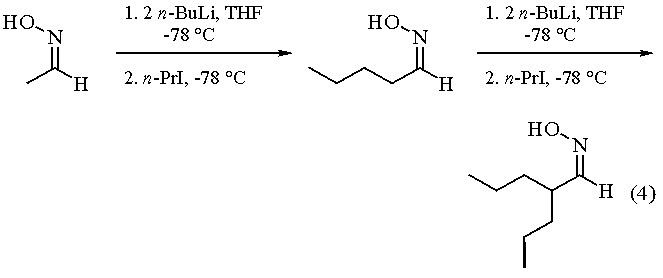 | ||
Appearance clear, colorless to yellow liquid | ||
Acetaldoxime is the chemical compound with formula C2H5NO. It is one of the simplest oxime-containing compounds, and has a wide variety of uses in chemical synthesis.
Contents
Properties
Acetaldoxime will often appear as a colorless liquid, or a white solid. Its solid can form two different crystallize modifications with needle-like structures, one melting at approximately 44°C-47°C for the alpha form, and 12°C for the beta form. The liquid is known to have a pungent odor, and is highly flammable. The compound can act as both an acid or a base, due to its acidic proton on the hydroxyl group and the basic nitrogen atom. The compound exists as a mixture of its Z and E stereoisomers (i.e. syn and anti, or cis and trans) in its normal form. The E stereoisomer can be isolated by slow crystallization of a distilled E/Z mixture.
Production
Acetaldoxime can be prepared by combining pure acetaldehyde and hydroxylamine under heating in the presence of a base.
The use of CaO for preparation of oximes has also been examined. It has been found that CaO react with various types of ketones and aldehydes under mild condition to give the corresponding oximes in a quantitative yield. CaO as an efficient reagent for the production of oximes from ketones and aldehydes in solid rate.
Reactions
A. Alkylation of Acetaldoxime
Deprotonation of acetaldoxime with 2 equiv of n-Butyllithium at -78 °C generates the dianion which reacts with Benzyl Bromide or 1-iodopropane to give excellent yields of a-alkylated (Z)-oximes. a,a-Dialkylation by further alkylation in similar way has been achieved. It is generally known that ketone oximes can be deprotonated and alkylated regiospecifically syn to the oxime hydroxy group. It is essential to perform the deprotonation and alkylation at -78 °C as otherwise no a-alkylated oximes are isolated, the major byproducts being nitriles.
B. Rearrangement into Acetamide
Heating of acetaldoxime in xylene in the presence of 0.2 mol % nickel(II) acetate or silica gel as catalyst caused isomerization into acetamide.
C. Synthesis of Heterocycles
Chlorination of acetaldoxime with N-chlorosuccinimide or chlorine gas in chloroform affords acetohydroxamic acid chloride, which suffers dehydrochlorination with Triethylamine to give acetonitrile N-oxide. The latter 1,3-dipole undergoes 1,3-dipolar cycloaddition to alkenes giving 2-isoxazolines in a one-pot procedure. This reaction is also suitable for the construction of more complex molecules such as the conversion of a 6-ethylideneolivanic acid derivative into the corresponding spiroisoxazoline.
Uses
Aldoximes such as acetylaldoxime are using during chemical synthesis processes as intermediates for chemical reactions. It is especially notable for its commercial application as an intermediate for the production of pesticides.
